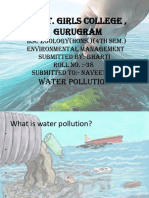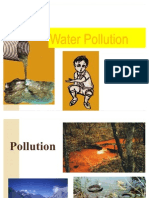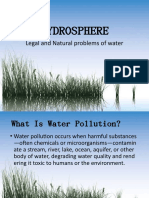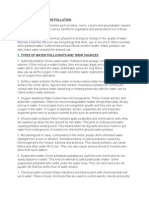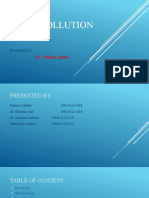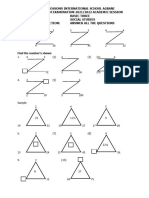0 ratings0% found this document useful (0 votes)
45 viewsSave Water
Save Water
Uploaded by
ParthaWater is essential for life but is an increasingly scarce resource. Nearly half of the world's population lives in areas with insufficient access to clean drinking water. By 2025, two-thirds of the global population could be living in water-stressed conditions if usage is not curtailed. Various human activities like industry, agriculture, sewage, and oil spills pollute water sources, endangering wildlife and ecosystems. Conserving water by fixing leaks, limiting shower time, running full loads of laundry, and using sprinklers efficiently can help address this growing crisis.
Copyright:
© All Rights Reserved
Available Formats
Download as PPTX, PDF, TXT or read online from Scribd
Save Water
Save Water
Uploaded by
Partha0 ratings0% found this document useful (0 votes)
45 views12 pagesWater is essential for life but is an increasingly scarce resource. Nearly half of the world's population lives in areas with insufficient access to clean drinking water. By 2025, two-thirds of the global population could be living in water-stressed conditions if usage is not curtailed. Various human activities like industry, agriculture, sewage, and oil spills pollute water sources, endangering wildlife and ecosystems. Conserving water by fixing leaks, limiting shower time, running full loads of laundry, and using sprinklers efficiently can help address this growing crisis.
Copyright
© © All Rights Reserved
Available Formats
PPTX, PDF, TXT or read online from Scribd
Share this document
Did you find this document useful?
Is this content inappropriate?
Water is essential for life but is an increasingly scarce resource. Nearly half of the world's population lives in areas with insufficient access to clean drinking water. By 2025, two-thirds of the global population could be living in water-stressed conditions if usage is not curtailed. Various human activities like industry, agriculture, sewage, and oil spills pollute water sources, endangering wildlife and ecosystems. Conserving water by fixing leaks, limiting shower time, running full loads of laundry, and using sprinklers efficiently can help address this growing crisis.
Copyright:
© All Rights Reserved
Available Formats
Download as PPTX, PDF, TXT or read online from Scribd
Download as pptx, pdf, or txt
0 ratings0% found this document useful (0 votes)
45 views12 pagesSave Water
Save Water
Uploaded by
ParthaWater is essential for life but is an increasingly scarce resource. Nearly half of the world's population lives in areas with insufficient access to clean drinking water. By 2025, two-thirds of the global population could be living in water-stressed conditions if usage is not curtailed. Various human activities like industry, agriculture, sewage, and oil spills pollute water sources, endangering wildlife and ecosystems. Conserving water by fixing leaks, limiting shower time, running full loads of laundry, and using sprinklers efficiently can help address this growing crisis.
Copyright:
© All Rights Reserved
Available Formats
Download as PPTX, PDF, TXT or read online from Scribd
Download as pptx, pdf, or txt
You are on page 1of 12
SAVE WATER
Water is a common liquid found on Earth.
Pure water has no smell , taste and color. Lakes , rivers , seas ,
oceans , ponds etc. are all made up of water.
DISTRIBUTION OF THE WORLD’S
WATER
WATER IS LIFE
• 40% of the world’s population do not have sufficient water for
adequate living and hygiene.
• India with 16% of the world’s population has only 4% of the fresh
water resources.
• Two out of every three people on Earth will have to live in water
stressed condition by the year 2025.
• 25% of the world’s population did not get clean water to drink.
• Some people don’t have enough freshwater where they live.
WATER POLLUTION
Now-a-days water pollution is caused due to human activities.
Examples of water pollution are following:
1)Industrial and factory wastes are one of the most prominent reasons of water
pollution.
2)The Green Revolution in India witnessed the increasing use of chemical
fertilizers , pesticides and insecticides in agriculture which led to water pollution.
3)Water coming through sewage is usually discharged into flowing rivers which
create havoc to the water animals , increase the BOD(Biological Oxygen Demand)
of water and make the water unsuitable for any use. This causes water pollution.
4)Oil spills cause long-term damage to the environment by polluting ocean
waters and killing different forms of marine life.
Top oil spills are following
a)Arabian Gulf / Kuwait- 19th Jan,1991 ; in Persian Gulf where 380-520 million
gallons oil spilled.
b)Gulf oil spill- 22nd April , 2010 ; in Gulf of Mexico where 206 million gallons oil
spilled.
c)1 Tox 1 oil spill- 3rd June , 1979 ; in the Bay of Campeche off Ciuded del Carmen
, Mexico where 140 million gallons oil spilled.
5)When warm or hot water is released into the streams and rivers by nuclear
power plants and certain industries ; the temperature of the natural water body
is raised which reduces plant life and causes large scale death of aquatic life.
6)If the radioactive materials are not properly disposed off after their use in
nuclear power plants and in industrial , medical and other scientific processes ,
their radioactive waste can have far reaching effects by polluting water.
An island of garbage and trash has been formed between the gyre of North
Pacific ocean. It was first discovered between 1985 and 1988. It was as large as
Texas state of USA. Many marine animals have been found dead in that island
after eating radioactive wastes.
Some images of water pollution are
following:
Wastage of Water
Daily , we waste water through our numerous activities like-
• brushing our teeth
• taking bath
• watering plants
• washing clothes
• cleaning the floor
• washing cars
• opening the tap without closing it for long time
CONSERVATION OF WATER
Some other ways of conserving water are
following:
• Check your home and school for leaky faucets and tell an adult if you
find one that drips.
• Take shorter showers and don’t fill the tub all the way when you take
a bath.
• Don’t leave the garden hose on all night when watering plants.
• Make sure the dishwasher and washing machine are full each time
your family does a load.
CONCLUSION
If the water wastes by every drop continuously then , 10 liters of water
wastes in a day , 300 liters waste in a month and 3600 liters waste in a
year.
Water is precious so it is better not to waste water. We should save ,
conserve water wherever and whenever we can.
You might also like
- Getting To Grips With Cold Weather Operations 2015Document136 pagesGetting To Grips With Cold Weather Operations 2015ali4957270100% (4)
- Your Water Footprint: The Shocking Facts About How Much Water We Use to Make Everyday ProductsFrom EverandYour Water Footprint: The Shocking Facts About How Much Water We Use to Make Everyday ProductsRating: 3.5 out of 5 stars3.5/5 (3)
- Water Pollution PresentationDocument35 pagesWater Pollution PresentationJeshwary Kumar100% (1)
- Book-Water Supply and Sewerage-Dr SajjadDocument275 pagesBook-Water Supply and Sewerage-Dr SajjadMirza Waqar Baig100% (4)
- A-Guide-to-Safe-and-Cost-Effective-Spillways - Peter Mason PDFDocument8 pagesA-Guide-to-Safe-and-Cost-Effective-Spillways - Peter Mason PDFFacundoNo ratings yet
- Mung Bean ReportDocument5 pagesMung Bean ReportDansonNo ratings yet
- Water Pollution: Presented By-Panchali Das M.SC Biotechnology 4 Semester BbauDocument23 pagesWater Pollution: Presented By-Panchali Das M.SC Biotechnology 4 Semester BbauJAYRAJSINH PARMARNo ratings yet
- Water Pollution Is The Contamination ofDocument4 pagesWater Pollution Is The Contamination ofShivam TripathiNo ratings yet
- Analysis of Water Sample Collected From Various Locations of Integral University, LucknowDocument39 pagesAnalysis of Water Sample Collected From Various Locations of Integral University, LucknowShrikant ShuklaNo ratings yet
- Unit 8 Part 2 - Aquatic PollutionDocument7 pagesUnit 8 Part 2 - Aquatic PollutionDERRICK FRIERSONNo ratings yet
- Pemeliharaaan Kualiti AirDocument15 pagesPemeliharaaan Kualiti AirCaroline LawNo ratings yet
- SC Water PollutionDocument14 pagesSC Water PollutionAmir Sabrin0% (1)
- Water PollutionDocument14 pagesWater PollutionSandri100% (1)
- SC Water PollutionDocument16 pagesSC Water Pollutionnor syazwani67% (3)
- Envisci Lesson 8water Use and ManagementDocument30 pagesEnvisci Lesson 8water Use and ManagementMaria100% (1)
- EPHRDocument26 pagesEPHRjosmamani6789No ratings yet
- Lesson 2 - Water and Waste Water ManagementDocument11 pagesLesson 2 - Water and Waste Water ManagementPaul Assie RosarioNo ratings yet
- water pollution pdfDocument6 pageswater pollution pdfmoharana1998No ratings yet
- Water Pollution 1Document23 pagesWater Pollution 1YOSEF DERDESAWENo ratings yet
- Water PollutionDocument18 pagesWater PollutionAkshayaNo ratings yet
- Unit V Water & Soil PollutionDocument37 pagesUnit V Water & Soil PollutionR TharunishNo ratings yet
- Water PollutionDocument63 pagesWater Pollutionsandhyapanicker1988No ratings yet
- Env. Studies (UNZILA NOOR)Document6 pagesEnv. Studies (UNZILA NOOR)unzila noorNo ratings yet
- Quality and Availability of Water CopyDocument51 pagesQuality and Availability of Water CopyjenzkyutieNo ratings yet
- Ge10 Topic 3Document19 pagesGe10 Topic 3Eriane Mae C. SamaneNo ratings yet
- Water Pollution Abdesadek ELKAHALDocument53 pagesWater Pollution Abdesadek ELKAHALAbdessadek El KahalNo ratings yet
- Water - Pol XC XcxcnmentDocument8 pagesWater - Pol XC Xcxcnmentpinky271994No ratings yet
- Experiment Time... : Presentation NotesDocument5 pagesExperiment Time... : Presentation Notessadia122No ratings yet
- Water Pollution and Its Control: Case StudyDocument13 pagesWater Pollution and Its Control: Case StudySE HariharasudhanNo ratings yet
- Water PollutionDocument35 pagesWater PollutionTan Sin YiNo ratings yet
- GEE 2 Lesson 1 Water Resources & Water PollutionDocument33 pagesGEE 2 Lesson 1 Water Resources & Water PollutionLuz DuhaylongsodNo ratings yet
- Ecology: Science ProjectDocument13 pagesEcology: Science Projectabdullah ahsanNo ratings yet
- Water PollutionDocument38 pagesWater PollutionmikramNo ratings yet
- Water Pollution Prevention and Conservation: How Do We Use Water?Document8 pagesWater Pollution Prevention and Conservation: How Do We Use Water?vegasabdulfatawNo ratings yet
- WATER POLLUTION (Edited Version)Document16 pagesWATER POLLUTION (Edited Version)Rashmi PriyaNo ratings yet
- 04.2 UNIT - 4 Surface Mining Env - IDocument135 pages04.2 UNIT - 4 Surface Mining Env - Inumendrakumarpandey2003No ratings yet
- Waterpollution 1Document19 pagesWaterpollution 1xaliw69962No ratings yet
- Water Pollution 7440 OnhBxnADocument18 pagesWater Pollution 7440 OnhBxnAamshafirozNo ratings yet
- Water PollutionDocument11 pagesWater PollutionFaris UlNo ratings yet
- Project On Water PollutionDocument20 pagesProject On Water PollutionSK SharmaNo ratings yet
- Water Pollution Final VersionDocument11 pagesWater Pollution Final Versionapi-279490884No ratings yet
- Pollution: WaterDocument11 pagesPollution: Watersarthakgurav06No ratings yet
- Water Pollution: Today We Are Gonna Learn About Water Pollution and The Causes of ItDocument11 pagesWater Pollution: Today We Are Gonna Learn About Water Pollution and The Causes of ItRUBEENA ASRAFF/No ratings yet
- Water Pollution, ModifiedDocument42 pagesWater Pollution, ModifiedzexmonliveNo ratings yet
- Water PollutionDocument27 pagesWater PollutionRangerNo ratings yet
- Jurnal 2. AppraisalDocument4 pagesJurnal 2. Appraisaletik ainun rohmahNo ratings yet
- Water Pollution and ControlDocument35 pagesWater Pollution and ControlSanthilal S Pillai100% (1)
- EPWM.pdfDocument17 pagesEPWM.pdfgauriishak29No ratings yet
- Water Pollution PresentationDocument60 pagesWater Pollution PresentationPreet Singh100% (1)
- Water PollutionDocument14 pagesWater PollutionSeychelleNo ratings yet
- Water Poll.Document14 pagesWater Poll.rjabeen.2005No ratings yet
- Reshma G Renjini S Christopher Kurian Sreenath N Joji Isac P V Rahini Amol KhanwalkarDocument31 pagesReshma G Renjini S Christopher Kurian Sreenath N Joji Isac P V Rahini Amol KhanwalkarManoj SatishNo ratings yet
- Legal and Natural Problems of WaterDocument31 pagesLegal and Natural Problems of WaterGenerous GorgeousNo ratings yet
- Ducksters ArticleDocument3 pagesDucksters Articleapi-644963967No ratings yet
- Water and SolutionDocument5 pagesWater and SolutionAlhamdi HaneefNo ratings yet
- Heramba Chandra College ProjectDocument11 pagesHeramba Chandra College Projectnkkabi9No ratings yet
- Water Pollution PPT Civil NITHINDocument18 pagesWater Pollution PPT Civil NITHINmudavath jagapathibabuNo ratings yet
- ES - Water PollutionDocument29 pagesES - Water PollutionVedant SharmaNo ratings yet
- Water PollutionDocument27 pagesWater PollutionROMEO JUTTNo ratings yet
- Water Pollution TP b38Document12 pagesWater Pollution TP b38Aaditya Pandey AmritNo ratings yet
- Water PollutionDocument16 pagesWater Pollutionwan habibahNo ratings yet
- PPTDocument18 pagesPPTKaran PreetNo ratings yet
- Did Your Can of Soda Kill A Whale? Water Pollution for Kids | Children's Environment BooksFrom EverandDid Your Can of Soda Kill A Whale? Water Pollution for Kids | Children's Environment BooksNo ratings yet
- ESL Chidren's WorksheetsDocument219 pagesESL Chidren's Worksheetsmargametal1978100% (4)
- Recovery of Acetic Acid by Means of Liquid-Liquid ExtractionDocument5 pagesRecovery of Acetic Acid by Means of Liquid-Liquid ExtractionAYALEYDENNo ratings yet
- Do You Wonder About Rain Snow Sleet and HailDocument26 pagesDo You Wonder About Rain Snow Sleet and Hailpatel pratikNo ratings yet
- JC Excellente Christian Academy Inc.: TOPIC: Energy Resources (Part 1)Document11 pagesJC Excellente Christian Academy Inc.: TOPIC: Energy Resources (Part 1)Ji PaoNo ratings yet
- Moisture ControlDocument34 pagesMoisture ControlYogesh YadavNo ratings yet
- Biology Sydney Olympic Park Research PaperDocument7 pagesBiology Sydney Olympic Park Research Paperklee71353No ratings yet
- Maria Montessori Holy Christian School Inc.: Third Quarter Science 1Document45 pagesMaria Montessori Holy Christian School Inc.: Third Quarter Science 1bayotNo ratings yet
- In Stream Hydrokinetic Turbine in Ruby, AlaskaDocument35 pagesIn Stream Hydrokinetic Turbine in Ruby, AlaskaThiago ValenteNo ratings yet
- 03 Secondary Wastewater TreatmentDocument36 pages03 Secondary Wastewater TreatmentDwinaRahmayaniNo ratings yet
- Assignment Matter in Our Sourroundings Class 9 09042015Document6 pagesAssignment Matter in Our Sourroundings Class 9 09042015Madhav LohchabNo ratings yet
- Upload 00129242 1526010566661Document20 pagesUpload 00129242 1526010566661A-selam IbraNo ratings yet
- Coastal Resource Assessment GuideDocument145 pagesCoastal Resource Assessment GuideArnoldAlarconNo ratings yet
- Hazop Hssam A HassaneinDocument41 pagesHazop Hssam A HassaneinRicardo BecNo ratings yet
- Blossom Second Term 2022Document36 pagesBlossom Second Term 2022confidenceanioluchiNo ratings yet
- Drafter CVDocument4 pagesDrafter CVachmad ismailNo ratings yet
- Design of Marina Structures and Facilities PDFDocument23 pagesDesign of Marina Structures and Facilities PDFUsha Sri G100% (2)
- Sterilization of Water Using Bleaching PDocument29 pagesSterilization of Water Using Bleaching PYash ManralNo ratings yet
- Measuring Enzyme ActionDocument3 pagesMeasuring Enzyme ActionsmolbransNo ratings yet
- CEP Course Time TableDocument1 pageCEP Course Time Tablehram_phdNo ratings yet
- Us6274778 Neosorb60Document7 pagesUs6274778 Neosorb60Tadeo FajardoNo ratings yet
- Ae Boiler Classification Fittings 43Document76 pagesAe Boiler Classification Fittings 43subham guptaNo ratings yet
- Gardeners and Growers Workshop 03Document58 pagesGardeners and Growers Workshop 03Peterson AlvesNo ratings yet
- MSDS NoratDocument3 pagesMSDS NoratFransiska FitriaNo ratings yet
- Technical Data Manual: Vitocell 300-H EHA SeriesDocument16 pagesTechnical Data Manual: Vitocell 300-H EHA SeriesLaith MahmoudNo ratings yet
- CP041Fen Bypass DampfkesselDocument12 pagesCP041Fen Bypass DampfkesselJoelCristobalNo ratings yet
- Green BuildingDocument25 pagesGreen BuildingprasannaNo ratings yet




































